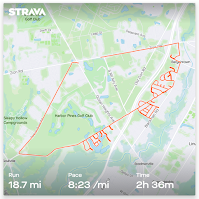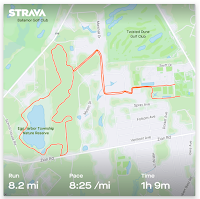 |
| An extremely festive truck seen during my long run! |
I hadn’t been feeling it the past week or so: the motivation to run, the excitement about current or potential running adventures, the anticipation when the moment comes to lace up your shoes and see where they take you, and yes even that feeling of accomplishment and mood boost that usually peaks at the finish of most runs has even been diminished or absent. I’m not sure what caused it. I could blame the shorter daylight hours or the colder temperatures. I could blame my lack of motivation to run on feeling tired after work and getting home after dark when I’m hungry and ready to eat dinner. Maybe it was fear of falling into this routine of honestly not wanting to go out for a run. Daybreak, work, sunset, travel home, relieve the wife of some parenting duties, dark, dinner, get the kids ready for bed, and now I’m too tired and it’s too cold and too dark to want to run. It was only a three day stretch without any running, but it felt like it could continue indefinitely and I felt powerless to change it.
Thankfully I had already planned to use some leave from work to take a long weekend. And even better, the weather warmed a bit for it to provide a nearly perfect running day temperature. I went out only with the intention to cover some new streets for the Every Single Street (ESS) project I am working on. I had an idea for my route planned which I thought would probably be about a 10 miler. I figured that would be good to get me back on the horse and get back into the right headspace again. Of course I had the option to lengthen the route with more streets of Egg Harbor Township I hadn’t run yet if I was feeling good and wanted to go longer. And as I should have learned by now, anytime I don’t specifically plan and map out a route for an ESS route, it is always longer than expected. I was out running. The weather was perfect. Things felt right again. Of course I extended the route and kept going longer than originally planned. I had thought it would be about 10 miles, but I told my wife I might be out for about 13. As the day would have it, I covered about 18.5 before arriving back home. The following day I ran another 8.2 miles at my most local trails.


Like all other runners, I have been told that rest days are as important as workouts. Likewise, I have also read about how important cross training and workouts besides running are for a runner’s longevity and to reduce the chances of injury. I don’t practice either of these as regularly as I know I should, especially as I get older. And I think that may be why I went through the bit of a funky period I did. I ran a much higher mileage November than I intended. I wasn’t building for anything, the weather was just good and I was finding more free time to run. Before I knew it, November was over and it was one of my highest mileage months of 2020. Maybe the overall lethargic lack of motivation I was feeling was my mind and body needing a reset. Maybe a couple lighter mileage weeks and a three day period without any running was just the reset that my body and mind needed. I certainly hope so. If yesterday and today’s runs are any indication, things are beginning to feel in place again.
Scott Snell
December 12, 2020







